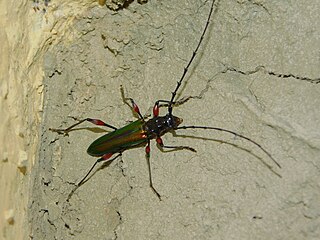The African Renaissance is the concept that the African people shall overcome the current challenges confronting the continent and achieve cultural, scientific, and economic renewal. This concept was first articulated by Cheikh Anta Diop in a series of essays between 1946 and 1960, later collected in a book titled Towards the African Renaissance. Diop's ideas were further popularized by former President of South Africa Thabo Mbeki during his tenure as Deputy President, where the African Renaissance continues to play a key role in the post-apartheid intellectual agenda.

The ring-tailed vontsira, locally still known as the ring-tailed mongoose, is a euplerid in the subfamily Galidiinae, a carnivoran native to Madagascar. It is the only species in the genus Galidia.

The Nubian flapshell turtle or Nubian soft-shelled turtle is one of two species of softshell turtle in the genus Cyclanorbis of the Trionychidae family. It is thought to have ranged from West Africa east through Central Africa to South Sudan, although it has been extirpated from the vast majority of its range.
Platycraniellus is an extinct genus of carnivorous cynodonts from the Early Triassic. It is known from the Lystrosaurus Assemblage Zone of the Normandien Formation in South Africa. P. elegans is the only species in this genus based on the holotype specimen from the Ditsong National Museum of Natural History in Pretoria, South Africa. Due to limited fossil records for study, Platycraniellus has only been briefly described a handful of times.
Polycynodon is an extinct genus of therocephalians from the Late Permian of South Africa. It is known from the Cistecephalus Assemblage Zone. The type species was first described as Octocynodon elegans by South African paleontologist Robert Broom in 1940, but the name Octocynodon was preoccupied by a genus of labrid fish first described in 1904. Along with John T. Robinson, Broom instated Polycynodon as a replacement name for O. elegans in 1948. Polycynodon is classified in Baurioidea, although its relationship to other baurioid therocephalians is uncertain.
Macrochoriolaus elegans is a species of beetle in the family Cerambycidae, the only species in the genus Macrochoriolaus.

Bothriospila is a genus of beetles in the family Cerambycidae, and the type genus of the tribe Bothriospilini. It contains two species: the type, Bothriospila elegans, found in Brazil and Paraguay, and Bothriospila pulcherrima, found in Brazil. The latter was described as a new species from Brazil in 2012. Bothriospila was circumscribed in 1923 by Swedish entomologist Per Olof Christopher Aurivillius.

Mionochroma is a genus of typical longhorn beetles in the family Cerambycidae. There are more than 20 described species in Mionochroma, found in the Neotropics.

Criodion is a genus of beetles in the family Cerambycidae, containing the following species:

Elaphidiini is a tribe of beetles in the subfamily Cerambycinae, historically also often spelled "Elaphidionini".
Centrocerum is a genus of beetles in the family Cerambycidae, containing the following species:

Pteroplatus is a genus of beetles in the family Cerambycidae, containing the following species:
Ommata is a genus of beetles in the family Cerambycidae, containing the following species:
Lamproclytus is a genus of beetles in the family Cerambycidae, containing the following species:
Catharesthes elegans is a species of longhorn beetles ; It is the only species in the genus Catharesthes.
Mionochroma elegans is a species of beetle in the family Cerambycidae. It was described by Olivier in 1790. It is known from Guadeloupe, Grenada, Dominica, and St. Lucia.
Centrocerum elegans is a species of longhorn beetles. It was described by Chevrolat in 1861. The species has a South American distribution and is found in Brazil, Bolivia, Paraguay and Argentina.

Calyptoproctus is a genus of planthoppers in the family Fulgoridae; records are from Central and South America.

Cordylomera is a genus of longhorn beetles in the family Cerambycidae. There are more than 30 described species in Cordylomera. They are found mainly in Africa, and Cordylomera spinicornis is also found in Europe and Temperate Asia.









